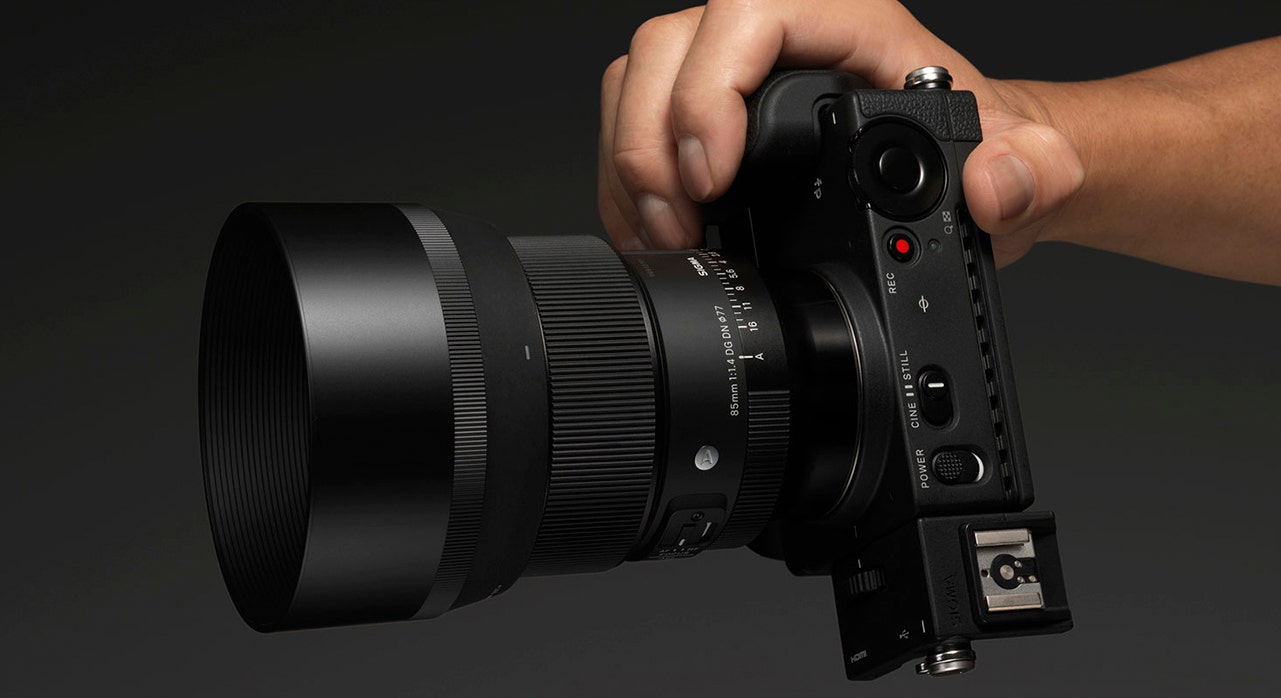24-70mm F2.8
DG OS HSM
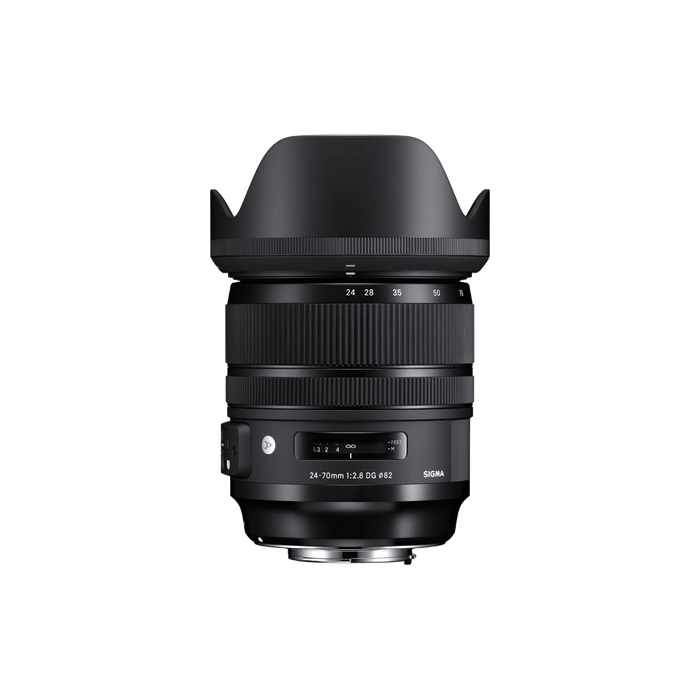

- Versatile standard focal range
- Outstanding image quality
- F2.8 constant aperture
- OS (Optical Stabilizer)
- HSM (Hyper Sonic Motor)
- Dust and splash resistant structure
- Water and oil repellent coating
- Exclusive low-dispersion glass
- Minimized flare and ghosting
- 9-blade rounded diaphragm
- Made in Japan
AWARDS
|
Rangefinder RF |
2017 |
|
TIPA |
2018 |
| Angle of view | Standard |
|---|---|
| Camera Type | DSLR |
| Lens Mount | Canon EF-mount, Nikon F, Sigma SA |
| Sensor Size | Full Frame |
| Construction | 19 Elements in 14 Groups |
| Angle of view | 84.1° - 34.3° |
| Number of diaphragm blades | 9 (rounded diaphragm) |
| Minimum aperture | F22 |
| Minimum focusing distance | 37 cm |
| Maximum magnification ratio | 1:4.3 |
| Filter diameter | 82mm |
| Dimensions (diameter x length) | Canon EF ⌀ 88 mm × 107.6 mm |
| Weight (g) | Canon EF 1020 g |
| Edition number | A017 |
| Supplied Accessories | Lens Hood LH876-04, Front Cap LCF-82mm III, Rear Cap LCR II, Case LS-576L |
| Accessories | WR Ceramic Protector Filter 82mm, WR Protector Filter 82mm, Mount Converter MC-11, Mount Converter MC-21, USB-dock UD-01 |
| EAN-code | Canon EF 085126576547 |
| Specifications Info | * Values are for SIGMA SA-mount Lenses for Nikon F mount with an electromagnetic diaphragm mechanism can be used with the following cameras. Z7Ⅱ※,Z7※,Z6Ⅱ※,Z6※,Z5※,Z50※,D6, D5, D4S, Df, D850, D810, D810A, D780, D750, D610, D500, D7500, D7200, D7100, D5600, D5500, D5300, D5200, D5100, D5000, D3500, D3400, D3300, D3200, D3100 Before using with one of the cameras listed below, please update the lens to the latest firmware version. |
The large-diameter standard zoom ideal for today’s ultra-high-megapixel digital cameras
Sigma’s Art line: a focus on high resolution
To fulfill the uncompromising image quality standard of the Art line, this lens features a power distribution that has been optimized in exacting detail. This is the lens for those who desire consistent resolution at maximum F2.8 brightness or lower and complete control of the beautiful bokeh effect.
Outstanding optical performance
Three SLD glass lens elements and four aspherical lens elements help minimize optical aberrations. To ensure outstanding image quality from the center to the edges of the photograph, the optical system minimizes coma, which causes points of light to streak, and transverse chromatic aberration, which cannot be corrected by adjusting the aperture. The optical system also minimizes distortion, which can be particularly evident in wide-angle shots, resulting in excellent optical performance throughout the zoom range.
Incorporating advanced aspherical lens processing technology
Aspherical lenses necessitate refined expertise in the design and manufacturing of advanced, high-performance lenses. Sigma’s representative products to feature this technology were the Sigma 12-24mm F4 DG HSM | Art and Sigma 14mm F1.8 DG HSM | Art, which both incorporated large ⌀80mm aspherical lenses as their front lens element.
Building on the success of these predecessors, the Sigma 24-70mm F2.8 DG OS HSM | Art incorporates an aspherical lens element that helps achieve extremely high resolution. This element is much thicker at the center than the edges, and forming its unusual shape is a feat of manufacturing technology. Moreover, Sigma processes the surface of this aspherical lens element with ultra-precise tolerances that are measured in hundredths of a micrometer. This extremely fine surface allows the Sigma 24-70mm F2.8 DG OS HSM | Art to deliver a very natural and smooth bokeh effect, without the visible concentric rings that afflict typical aspherical lens elements.
A 24-70mm F2.8 lens that meets the high standards of the Art line
Sigma has continuously pioneered 24-70mm F2.8 lenses that are a step ahead of the times. The first model of this specification, Sigma 24-70mm F2.8 EX DG ASPHERICAL DF, launched in 2001. Representing the fourth generation of the family, the new Sigma 24-70mm F2.8 DG OS HSM | Art accomplishes a challenging feat in optical design: incorporating optical stabilizer functionality in a large-diameter standard zoom. By leveraging all of its design and manufacturing expertise, Sigma has ensured that this new lens fulfills the uncompromising requirements of the Art line for image and build quality.
Bokeh that is a cut above
At wide-open aperture, this lens offers outstanding photographic expression. The area in focus is extremely sharp, while the background exhibits a beautiful bokeh effect with only slight spherical aberration. Since large-diameter zoom lenses are often used at wide-open aperture, Sigma has paid close attention to the shape of the bokeh, aiming for perfect circularity.
Exclusive low-dispersion glass
The degree to which light is refracted by glass depends on the light’s wavelength. This fact causes different colors of light to focus at slightly different points. The result is chromatic aberration, the color fringing that is particularly noticeable in telephoto lenses. Most chromatic aberration can be removed by combining a high-refractivity convex lens element with a low-refractivity concave element. Yet residual chromatic aberration known as “secondary spectrum” may still remain. To minimize this secondary spectrum, which can be a serious issue with conventional lenses, Sigma lenses feature up to three types of exclusive low-dispersion glass offering superior performance: ELD (Extraordinary Low Dispersion), SLD (Special Low Dispersion) and FLD (“F” Low Dispersion). In particular, FLD glass offers ultra-low dispersion in combination with high transmittance and the anomalous dispersion characteristics of fluorite. Meticulous deployment of these types of exclusive low-dispersion glass and optimization of power distribution gives Sigma lenses superlative image rendition undiminished by residual chromatic aberration.
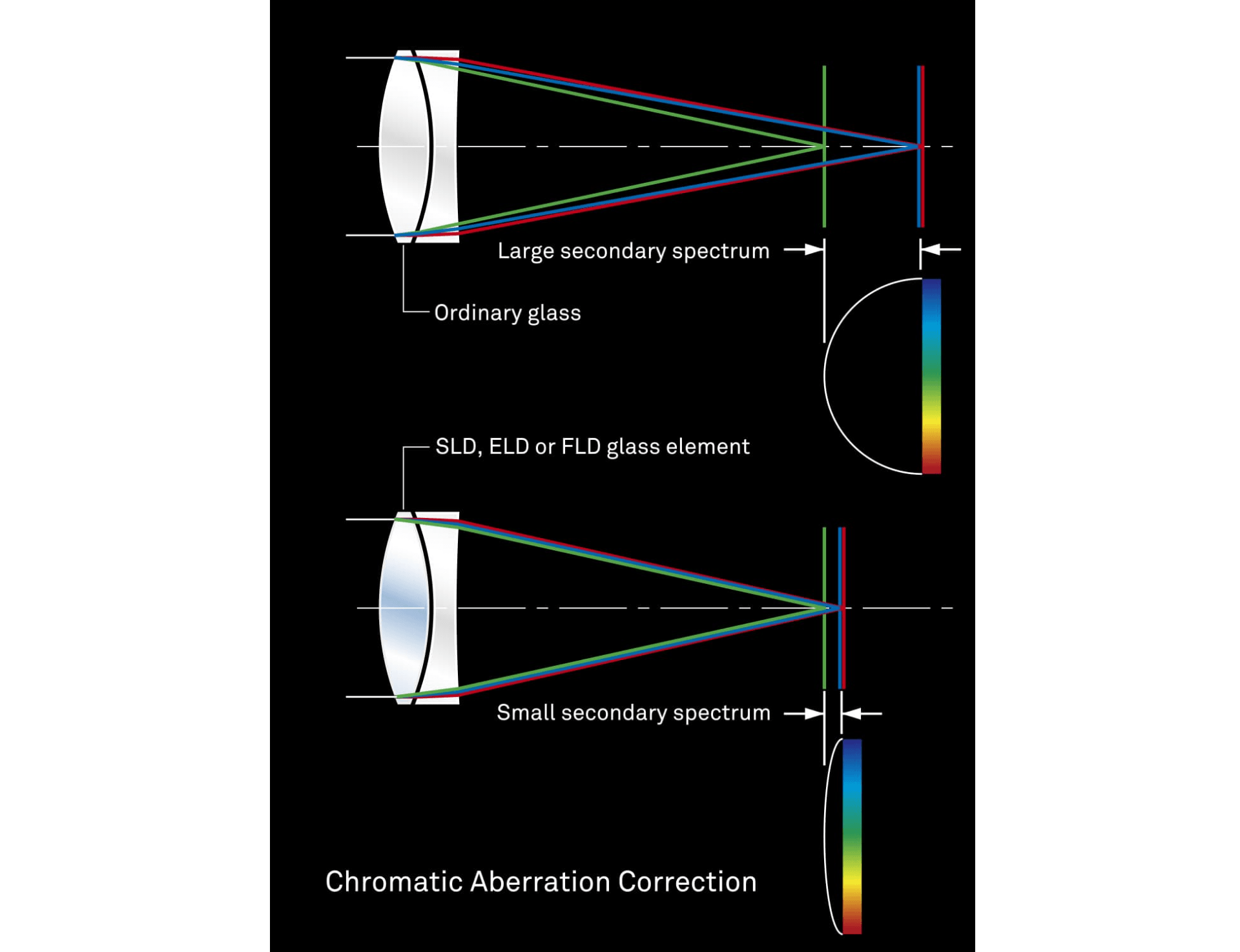

Designed to minimize flare and ghosting
From the start of the design process, Sigma measured flare and ghosting to establish an optical design that is resistant to strong incidental light sources such as backlight. At the prototyping stage, Sigma used not only simulations but actual photographic experiments to assess flare and ghosting under multiple criteria, identify the causes of these issues under a wide range of situations, and take measures to mitigate them. In addition, Sigma’s Super Multi-Layer Coating helps further reduce flare and ghosting and provide sharp, high-contrast images even in backlit conditions.


OS and other features for success on any shoot
OS functionality, newly designed HSM, mount with dust and splash resistant structure, electromagnetic aperture control (for Nikon), and more
This lens has all the features and functions photographers need to be successful on a wide variety of shoots. In addition to outstanding image quality, this lens offers autofocus, construction that minimizes the incursion of dust and debris, an optical stabilizer (OS) function, and more. To make this lens as easy to use as possible by photographers in all fields, it features not only Sigma’s most advanced mechanical systems but also the company’s latest software.
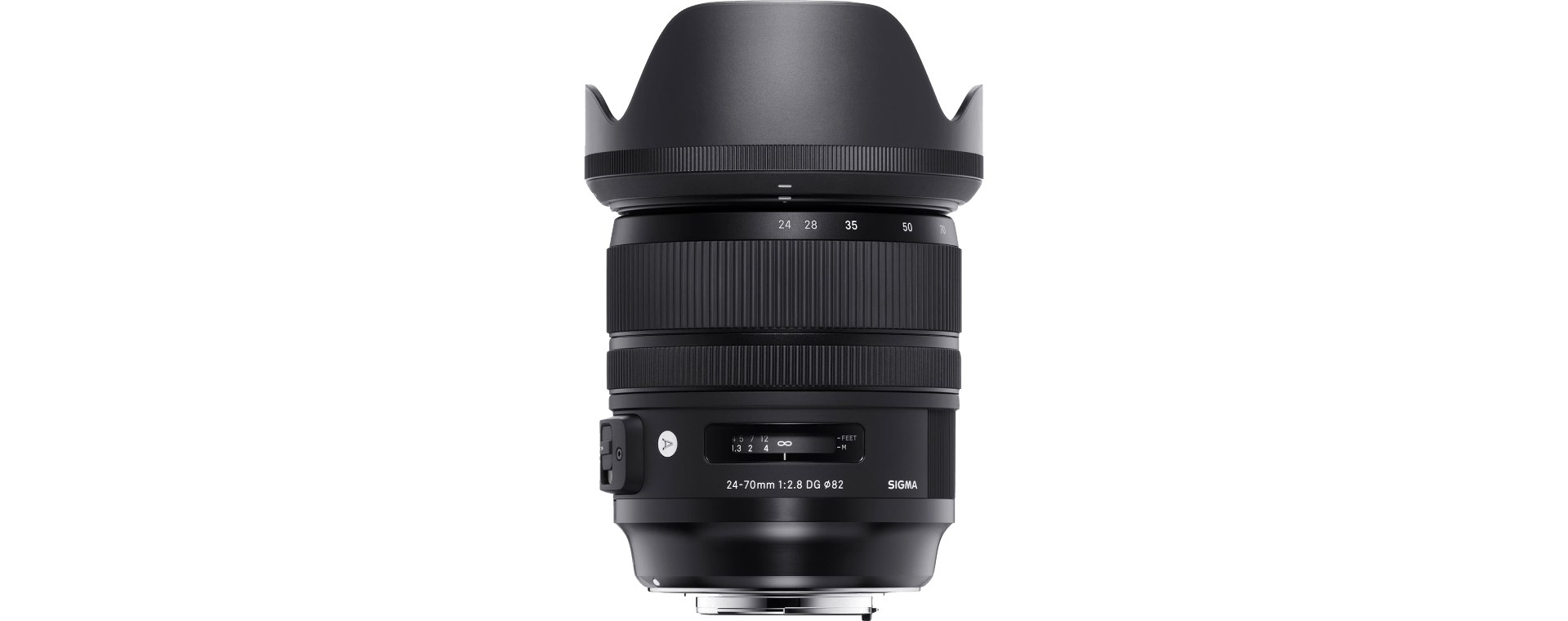

Incorporating the OS function for success on any shoot
Designed for use in a wide variety of situations, the optical stabilizer (OS) offers a powerful stabilization effect of 4 stops*.
* Based on CIPA guidelines. Measured at the telephoto setting on a camera with a 35mm full-size image sensor.
Lens barrel designed for high rigidity
Since large-diameter standard zoom lenses tend to serve as a go-to lens and see frequent use, the Sigma 24-70mm F2.8 DG OS HSM | Art is designed to stand up to the challenging shooting environments that pros encounter. To this end, the lens barrel contains a large amount of metal, while the external moving parts feature thermally stable composite (TSC), which is resistant to thermal expansion and contraction. This structure contributes not only to the outstanding optical performance of the lens but also to its high rigidity and confidence-inspiring build quality.
Newly designed HSM for fast AF performance
The newly designed hypersonic motor (HSM) offers 1.3 times the torque of its predecessor. Even at low speeds, it offers exceptionally stable performance.
Nikon electromagnetic diaphragm mechanism included
The Nikon mount version of this lens includes an electromagnetic diaphragm mechanism that allows it to receive the appropriate signals from the camera body. This feature ensures precision diaphragm control and stable Auto Exposure (AE) performance during continuous shooting.
Fast AF with full-time manual focus
Full-time manual focus function allows the lens to be switched to manual focus simply by rotating the focus ring.
Note: The operation of full-time MF may vary based on mount type.
Mount with Dust and Splash Resistant Structure
Since the area of the lens most vulnerable to dust and other foreign bodies is the mount, rubber sealing* helps provide peace of mind. In addition, the front lens element features a water- and oil-repellant coating that helps the lens perform well in the rain, near water, and in other challenging conditions.
* Except for Sigma mount
Rounded diaphragm
The 9-blade rounded diaphragm creates an attractive blur in the out-of-focus areas of the image.


High-precision, rugged brass bayonet mount
The brass mount combines high precision with rugged construction. Its treated surfaces and enhanced strength contribute to the exceptional durability of the lens.
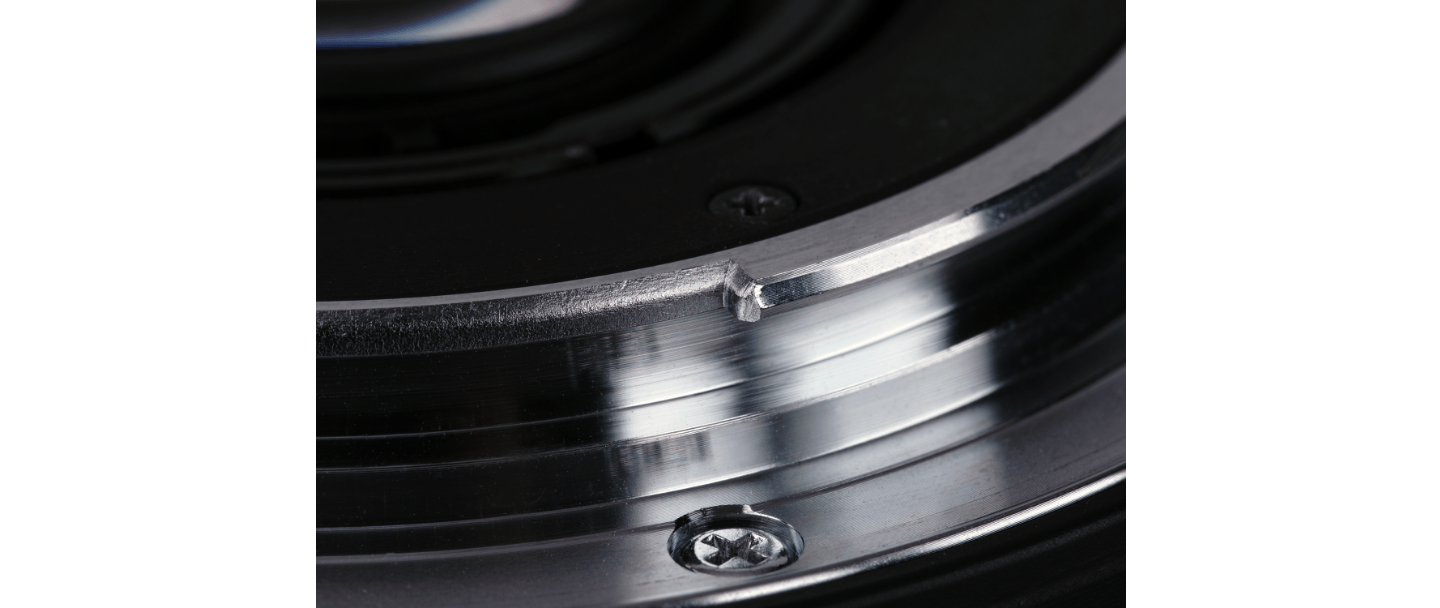

Nikon electromagnetic diaphragm mechanism
The Nikon mount version of this lens includes an electromagnetic diaphragm mechanism that allows it to receive the appropriate signals from the camera body. This feature ensures precision diaphragm control and stable Auto Exposure (AE) performance during continuous shooting.
High-precision, rugged brass bayonet mount
The brass mount combines high precision with rugged construction. Its treated surfaces and enhanced strength contribute to the exceptional durability of the lens.
Mount with Dust and Splash Resistant Structure
The lens mount incorporates rubber sealing to protect the mount from dust and water drops.
Water and oil repellent coating
Incorporates a water and oil-repellent coating that allows water to be wiped away easily and prevents oil and fat from sticking to the surface, even in challenging shooting conditions. At the same time, the maintenance of the lens surface becomes easier.
HSM (Hyper Sonic Motor)
The Hyper Sonic Motor (HSM) is an original SIGMA development that uses ultrasonic waves to drive the autofocus mechanism. Its extremely quiet operation helps avoid disturbing photographic subjects. High torque and speed assure rapid autofocus response. SIGMA uses two types of HSM: ring HSM and micro HSM. The Ring HSM configuration permits manual fine tuning of focus (manual override) by turning the focusing ring after autofocus is complete.
Rounded diaphragm
The polygonal shape of a conventional iris dia phragm causes out-of-focus light points to appear polygonal. A rounded diaphragm is designed to pro duce rounded out-of-focus light points when opened to near maximum aperture. This creates attractive bokeh effects in many situations, such as when pho tographing a subject against an out-of-focus surface of water from which light is being reflected.
OS (Optical Stabilizer) function
SIGMA's original OS (Optical Stabilizer) function uses sensors inside the lens to detect any motion, then moves specific lens elements in order to effectively minimize blur caused by such movement. Owing to the stabilized image in the viewfinder, it is possible to fine-tune composition and ensure accurate focusing.
Exclusive low-dispersion glass
The degree to which light is refracted by glass depends on the light's wavelength. This fact causes different colors of light to focus at slightly different points. The result is chromatic aberration, the color fringing that is particularly noticeable in telephoto lenses. Most chromatic aberration can be removed by combining a high-refractivity convex lens element with a low-refractivity concave element. Yet residual chromatic aberration known as "secondary spectrum" may still remain. To minimize this secondary spectrum, which can be a serious issue with conventional lenses, SIGMA lenses feature up to three types of exclusive low-dispersion glass offering superior performance: ELD (Extraordinary Low Dispersion), SLD (Special Low Dispersion) and FLD ("F" Low Dispersion). In particular, FLD glass offers ultra-low dispersion in combination with high transmittance and the anomalous dispersion characteristics of fluorite. Meticulous deployment of these types of exclusive low-dispersion glass and optimization of power distribution gives SIGMA lenses superlative image rendition undiminished by residual chromatic aberration.





